I have seen many recommendations - many different recommendations - and I must admit that I personally hesitate to recommend any particular type, make or model of kayak.
Perfect for the adventurous flyfisher; fast, flexible, fun.
My kayak endeavor actually started in a float tube. Fishing from places other than the shore or shallows gave me a taste for moving about in more than one direction when I was fishing. Up and down the bank was not enough. I wanted to get out too. The tube was neat, the kayak is ideal.
From tube to kayak
|
|
|
|
I used to fish a lot from a float tube. I do not any more.
Sure, the tube is a great way to fish. It opens new water to you and brings you places that you could only dream about when you were wading or fishing from the bank.
But even though the float tube is a versatile and very useful vessel, it has some drawbacks. The most important one is speed - or lack of same.
In my kayak I can move along much faster than in the tube. Actually even faster than when walking on the bank. I often find myself taking the kayak to places where I intend to wade just because it brings me to new places so fast.
The kayak is heavy and hard to handle alone, and you cannot pack it on a horse or in the trunk of a car. But if you have access to a car with a carrier on the roof, driving with a kayak upside down on the car is no problem. And modern kayaks are so lightweight that you should be able to tumble them by yourself.
It is all about kayaking
This article will help you select a kayak for fishing, try to teach you some tricks that will make fishing from it a great experience, and try to tell you about some of the precautions you have to take when heading out in a kayak.
You might have a kayak already. You might have a friend who has one. But you might still never have thought about combining kayaking and fly fishing.
The article is divided into three parts:
1) Selecting and preparing a kayak... and yourself...
2) Safety when kayaking.
3) Flyfishing from a kayak ...and selecting the right flyfishing gear.
Select the right kayak for fly-fishing
I have seen many recommendations - many different recommendations - and I must admit that I personally hesitate to recommend any particular type, make or model of kayak.
Most fishers, myself included, have chosen a so called sit-on-top model, that facilitates getting in and out, but 'real' kayaks of the arctic/greenlandic design with a deck and a hole are just as well suited. The drawback is a bit more difficulty in entering and leaving, while the advantage is superior speed in many of the closed models.
But still, judging from books and magazines the open ones seem to be preferred by most fishers. I would not exclude one for the other, but give both designs a try before I bought. I chose the open one because my kayak is not only a fishing vessel, but also a means of transportation, and I want to be able to get in and out with no hassle... and with my waders and large wading boots on.
No matter what you do, make sure you get a stable model. These are typically slower and a bit harder to paddle, but nothing that will have influence on your fishing. Stability will! The more stable, the more maneuvers you can do unpunished. Go for stable hull shapes and wide kayaks.
Some kayaks are or can be fitted with a rudder. That is worth considering. Kayaks float high and tend to drift and turn in the wind. A rudder, which is operated with your feet, is a great help in keeping position and direction.
I will not recommend specific brands or models either, because there are so many out there and I have tried so few. The only things I will recommend is aiming for light weight and easy maintenance. Most modern kayaks are made from some kind of polycarbonate, which is both light and very sturdy. Kayaks can also be made in wood or glass fiber, which is heavy, and more exotic materials such as carbon fiber, which is expensive, or fabric over a frame, which is indeed charming (and lightweight), but also more vulnerable than any of the other materials.
Folding kayaks are an option if you need to pack really compact, but not in itself a benefit to your use of the vessel.
Other kayak gear
You need a paddle. Take what the dealer recommends within your price range. You might consider a two piece paddle for easier transportation, but a one piece has offered me little hassle over the years.
A personal flotation device is a must if you want to travel or fish over deeper, colder water. You WILL roll over! Be prepared. A tight fitting sailor's vest or small self inflatable vest is the right choice. Make sure it does what it is supposed to. Try it in warm water. The best ones have radar reflectors, a whistle and other stuff that you will appreciate when you are in. Do not go cheap here! See the chapter on rolling over below.
If you fish warm water only, and you are an able swimmer, the life vest is not necessarily a must.
I will cover more security equipment in the section on security.
Some kayaks come without a soft seat. Judge for yourself whether you need one or not, but I find my soft seat very comfortable. It offers soft cushioning and a backrest plus a large pocket that usually holds my thermos, drinking bottle and lunch pack. Seats are fitted in different ways. Mine detaches for washing and drying and I usually stove it indoors.
You can buy kayak clothing, which will set you back hundreds of dollars. Specially designed wet suits, breathable jackets, soft shoes and what-have-you. If you fish cold water and have the money, go for it. I personally use my usual fishing garments: neoprene or breathable waders, wading boots and fishing jacket. It works fine!
If you fish deep and in waves, get something that fits tight. Loose, breathable waders will fill with water if you go in. Tight neoprenes will help you float and not fill up with lots of water. And do not believe anybody who says the waders and sailing do not combine! You will not turn upside down, but float nicely with your legs in the surface.
I have always brought an anchor. It is convenient and keeps you in place in wind and current. It is also a safeguard. If your kayak rolls over the anchor drops to the bottom, and the kayak is fixed. A small 0.5 kilo or 1 lbs. anchor will hold the kayak. A small piece of chain just above the anchor will aide its grip.
Keeping stuff dry is important. Clothes, food, gear. Dry bags are available in all sizes and shapes. After having rolled over with a 500 dollar cellular phone in my pocket, I now even have a small one for the phone! Cameras, phones and the like does not take a dunk in the water lightly.
Whether you intend to fish from the kayak or just use it as transportation, rod holders of some kind is necessary. You can basically select two strategies: vertical or horizontal.
Horizontal usually means simply strapping the rod down over the deck. Make sure the rod tip is free of the water if you point it forwards, and prefer a location behind you with the tip pointing towards the rear. Here the rod is less exposed and you can paddle freely. The disadvantage is access. If you suddenly want to grab the rod and fish, finding and freeing it behind you is of course less convenient than in front of you. A strap system with velcro or rubber band will help you.
Vertical rod holders compromise of a vertically mounted tube with a slot for the reel. You set the handle and reel into the tube and strap it down with velcro. The tube(s) can be mounted away from you in the front of the kayak or right behind you. Accessing the rod is usually convenient and quick. Two rods can be mounted pointing each their way.
Do not mount them close and parallel! Fly rods and lines have an amazing ability to tangle when carried close for a long time. And the distance to that tangled tip is even longer when sitting in a kayak.
Straps and bungy cords are a very nice addition to the equipment. Straps over the deck or open spaces offer easy attaching of all types of equipment - for a longer duration while you sail or just for a minute or two while you do something else with your hands.
Ice boxes or other types of lidded or open boxes can be very practical. Most standard boxes of a limited size can be fitted on the kayak. Closed kayaks have limited on deck space, while open ones can house even large boxes. Something waterproof is of course preferable.
Stay safe while kayaking
This is fun but no game. Accidents happen every day to small vessels, and taking the right precautions will keep you out of these sad statistics.
|
|
The most important factor is the weather. Ideal kayak weather is calm and not too cold. Wind is not a big problem, but can be very annoying, while waves can be dangerous. Sailing in waves is absolutely possible, even in big ones, but it demands skill and concentration and combines very poorly with fishing. The same can be said for whitewater, which can be great fun - if you wear a helmet and are prepared to be very wet! Smooth water or ripples and not too fast moving water is the ideal water for the kayaking flyfisher.
Unclear conditions such as fog, heavy rain or snow (!) is also a deterrent. Do not take chances. It is supposed to be fun and not a life threatening challenge.
Even the calmest water is still a killer if it is cold enough. Water temperature should always be taken into consideration. Water close to the freezing point is a merciless death if you are not equipped with a survival suit. Even a wet suit can be too cold and normal garments or waders will offer little protection.
At close-to-freezing temperatures you will last only a few minutes in the water, and battling to get back into your kayak will probably only make things worse. So stay away from the coldest water.
Medium cold water 8-12 degrees Centigrade (45-55 F) will not be a threat, but certainly be cold! A wet suit or neoprene waders will help.
Above that you might gasp a bit, but even without special garments you will be fine for quite a while.
In really warm water, such as in the tropics, a dip might even be an added bonus.
As mentioned above, seriously consider acquiring a vest. The best you can afford, and do not be a cheapskate! This is a very easy and convenient way of saving energy if you fall in. You can float conveniently while you gather your thoughts and enough strength to empty your kayak and get back on board.
The inflatable ones are really neat: small when not in use, good floaters when inflated. But my experience shows that getting back on board with two huge air filled sausages on your front is not easy. A compact sailor's vest is more like it. Even though it will not float you as well, it will make getting back onboard a lot easier.
Fishing from a kayak is like diving: never do it alone. Have someone with you or have someone on the beach, who knows where you are. This is of course more important when fishing remote areas than when fishing populated and well trafficked areas.
If there is cell coverage where you are going, bring a cell phone. It is an easy and inexpensive safety device. Keep it in a dry bag. A standard plastic bag allow you to operate it without taking it out. In other places NMT phones or radios with longer reach have to take the place of the cellular type.
A whistle can be helpful in alarming other boats nearby. Many vests have one stuck on permanently. If not, go to a ship supply store and buy one for the purpose.
While you are in the store, get a couple of flares. It is unlikely that you will need them, but just in case. One day you might find they are just what you wanted.
If you plan on fishing early or late - or just sail out or home in the dark - you will need lamps. Any other boat traffic will not stand a chance of seeing you without. Any small bike type of lamp will do, but a proper red/green/white combination will be better. Put them on a small mast behind you, but consider first of all whether to go out in the dark at all. A kayak is not an ideal all night ship.
You WILL roll over!
I have friends who fish from a kayak and never went in. It is possible. But even so you still need to pretend that you will eventually roll over and fall in. This has several implications:
1) Strap on everything! If you do not want to loose that expensive spare rod, strap it on. Your extra jacket. Your lunch pack. Camera. Everything. Things you need to use, you can attach with long, elastic bungy or spiral cords, while stored items can be strapped down. Many kayaks have permanent straps, meshes and hatches. Use them! And get a strap for your paddle too. It is most likely to slip overboard when you are casting or fighting a fish.
2) Keep things dry. Pack everything sensitive in water proof bags or containers. Special bags are available, but heavy plastic bags and a knot can do the trick. Take specially care of cameras, binoculars, cell phones, non-waterproof GPS's and other electronics, but being able to eat a dry lunch is not bad either...
3) Learn to get back onto or into your kayak. Being far offshore and having to swim dragging a kayak is no fun. If the water is cold, getting out of it is very important. Cold water kills.
4) Be prepared. Try provoking a roll it in warmer water. A summers day on the beach or in a pool is great for learning the limits and behavior of your kayak.
Try it and learn to control everything. It is unlikely that you will need it, but then again, so is heart massage...
Kayak and waders
I always have my waders on when I go out in the kayak. The water is fairly cold where I fish and I like the advantage of being able to get off and wade a bit. But one dip in my breathables have taught me to wear neoprenes. I once fell in in deeper water, and my comfortable, baggy breathable waders filled with gallons of water - so much that I was almost unable to haul myself onboard the boat that came to help me! And I would NEVER have been able to get into the kayak unless I had taken off the waders.
The tight neoprenes will keep tight and only let in small amounts water. Add a belt or a piece of string around your waist to enhence this tightness. They will also aide in keeping you warm while you swim. so wear neoprenes or a suitable wet suit in cold water - and remember that cold water kills.
How about fishing then?
OK, enough talking about all the serious stuff! On to the fun... flyfishing.
You have the kayak. You have the rods. You have all the gizmos and gadgets. Now you want to use them.
Well, preparing for a flyfishing trip in a kayak is much like preparing for any flyfishing venture. Gather your stuff, make sure you brought everything and set out.
Find an appropriate spot to start and land. The best spots are regular, shallow banks or beaches with sand and no surf or strong currents. A small, low pier is of course very convenient, but the best fly fishing spots rarely have piers.
You need to be able to get into the kayak while it is almost freely floating and the push off. Sit-on-tops can be entered almost anywhere as long as you can get onto the kayak. Regular, closed Greenlandic style kayaks are best mounted on a flat beach or from a low pier.
I usually secure all gear to the kayak while it is on the beach or bank and then drag it into the water wading next to it and then enter. A friend who has a closed type kayak routinely enters the kayak while it is on land right at waters edge, and pushes it off with the paddle.
Make sure you have everything and paddle off!
Flyfishing gear for kayakers
As a kayaking flyfisher you will need little else than you usually tote along. Any rod suited for your usual fishing will be suited for the same type of fishing from a kayak. Rod length, line weight and density should reflect your quarry and not the fact that you are in a kayak - or was transported to your destination in one.
One thing is worth remarking though: kayaking brings you over deep water, and herein lies a new fishing experience for most flyfishers.
Fishing over 5 or 10 meters or up to 30' of water requires a new strategy, which includes sinking lines and heavy flies. A lot of action is hidden in the abyss - relative to the usual depths covered by flyfishers.
Striper fishers who fish from a boat will be well prepared, but if you usually go for trout, pike, bass or other species hunted close to the surface, your will almost certainly have to gear up - or rather down - for some deeper fishing.
In most cases a sinking line will do, but fast sinking shooting heads, heavier rods and maybe even longer rods can become necessary to cast a fly that will reach the bottom.
If you fish the salt the usual precautions apply: use gear which can take the environment. You WILL roll over, and the reel(s) will be drenched in saltwater. Same thing goes for fly boxes, tools and other items you bring with you.
Finding a spot
Finding good fishing spots is no more difficult from a kayak than from any other vessel or from the bank or beach. You have a large variety of choices, and will no longer be limited to the shallow parts close to the water's edge.
You can aim for deeper parts, large pools, rocks, jetties or any interesting structure available. When you arrive leave your paddle on your lap or tuck it under a strap.
Get out the fly rod, strip line, take aim, and cast.
Casting from a kayak
Casting from a kayak is actually easier than casting from a float tube. Imagine yourself sitting in a chair. That is about how it is sitting in a kayak. A rocking chair maybe...
You can easily cast in any direction in front of you. Most convenient is casting across the kayak from your casting arm side.
You can position yourself as you please considering waves and wind. In most cases the kayak will swing around and wind up pointing in the same direction as the wind. This is a convenient position for casting if the wind is not too strong.
If you put out an anchor, you can attach the line on the kayak in such a way, that you guide its direction as you want. Remember that the kayak will swing away from the attachment point and stay roughly in that position. I have several attaching points on my kayak, and can make it end up sideways or with front or back to the wind.
It goes without saying that wild movements are not a good idea. You can cast with force, use double hauls and make power casts, but take care not to get too physical or aggravated in your casting style.
Retrieving
You can strip line as you always do if your fishing requires stripping. You will probably soon discover a problem: where to put the line. Putting it in the kayak is an option if you have a sit-on-top, and so is in the water.
Neither is very good.
Having the line in the kayak is bound to result in tangles. Line will invariably find its way to straps, shoelaces, anchor and whatever there might be in the bottom.
On the water is usually much better, but not ideal. The current will most likely grab the line, and give you more resistance than you might want.
You might consider some kind of stripping basket, realizing the limits that it will impose on your stripping pattern. Another option is an apron as they are known from float tubes. These are usually made from a mesh and has no rims, but just create a flat, unobstructed surface for the line to lie on. In the sit-on-top such an apron can be fitted without problems, but the closed kayak is more restricted in this respect.
You can also simply hold the line in large loops in your line hand while casting, letting go as needed.
Luckily you have great help in the fact that long casts are usually not needed. Aim shorter than you usually do, and if you are fishing deep, locate yourself over the fishing spot and roll cast a few times to feed out line. The sinking lines are a menace if they get in the water and under the boat.
I retrieve as I usually do with two drastically different weapons that I utilize now and again: bottom scraping and two hand retrieve.
Scraping the bottom means fishing the fly slowly on the bottom making as much disturbance as you can. This is done with sinking lines and a sinking fly or leader. The fly must be on the bottom to stir up mud and make noise. If you do not feel the bottom and occasionally snag, your are not deep enough. Many bottom feeding fish find this irresistible. Once you feel a fish, man an erratic strip and let the fly sink again. Do not give up right away. The fish often seem to follow the fly over the bottom for a while and hookup rarely happens in first try.
The two hand strip is quite the opposite. I fish the line floating and the fly in the surface or top water and strip as fast as I can. A baitfish imitation fished this way will entice a freely swimming predator, and my notion is that the pursuit is usually short. And I know the strike is sudden and forceful!
Catching
Fish behave differently when caught in deep water. Of the many trout I have caught I cannot remember one that jumped. This is usually the case if the fish has less water to move in, but in deeper water the fish will seek the bottom, and most fish I have caught - except for the fast swimming pelagic garfish - will go deep.
This means that you will be pumping fish. Pumping is the term used for pulling in fish with the rod only and then reeling the gained line on the reel while keeping the fish tight, but not pulling further.
Pumping is very effective when drawing fish up from the depths, but also a very powerful way of exerting force on your gear and the hook and tippet. I have had my rod tip touch the water on several occasions - even though the handle was close to vertical - in the other direction! And I have broken off many fish in the abyss because I just lifted their weight and forgot to consider their ability to swim down.
So remember the virtues of fighting fish: tire them and then reel them in. Deep dwelling fish are not weaker than their surface scooting brethren. You just do not see them scoot.
One important thing though: keep the fish free of the bottom. It is usually littered with suitable objects, just waiting for a fish that wants to rub free.
Landing
I prefer landing my fish with my hands, but a net can be nice to have if your quarry is in a size class that lends itself to nets (I have seen pictures of sailfish and tuna caught from kayaks!). A short shafted net is fine. The distance to the surface is limited. Unhook and release - if you are so inclined - or kill the fish and keep it in the water on a stringer or in a keep net. Pull the fish into or onto the kayak when sailing. A plentiful harvest is not the most aquadynamic appendage you can have trailing after you.
- Log in to post comments

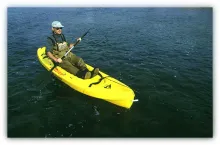
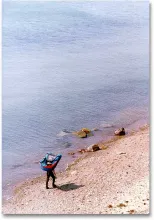
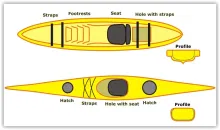





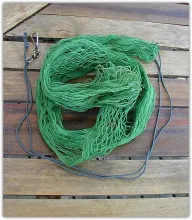
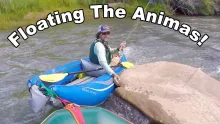
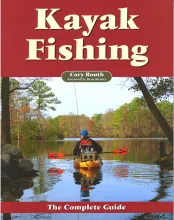
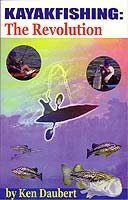
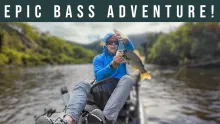
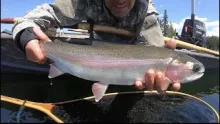
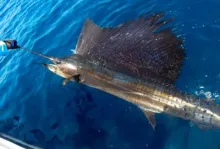

Most fly anglers pre
Most fly anglers prefer to stand up when casting. It gives them a better view and make casting easier.
However, the sea going kayak designs simply are not made for it.
I WILL stick my neck out and recommend a wide, stable Sit-On-Top kayak design for fly casters. Look for a design that has a seat mounted on a frame separate from the hull. They not only are easier to achieve a standing position from, but they prevent the dreaded "swamp @ss" one gets when in a hull-molded seat.
These will start at about $1000USD - and go up from there. But they are purpose designed for fly casting and there is little substitute. Try one once and you will see what I mean.
Just a few points I
Just a few points I want to add:
the slim seakajak is much faster and with a sidebar/outrigger(I dont know the word, but it is like a 2nd little slim boat attached to the side of the kajak) it cant roll over, unless you go out when a tornado is on its way. 10 miles durin a day is nothing. its flat and slim . Wind cant blow it away as a sit on top.
Paddlers usually wear a Longjohn - a neat combination of neopren covering your body . If you fall into the water a thin layer of water will come in and will be warmed up. So you will have 2 isolations against cold water.Wear this part instead of neoprene waders. Its more flexible, shoulders are covered and in any case it is more secure when swimming.
Use a roofrack with an extendable/pull out rod. to place a kajak on the roof of the car just pullout the rod; then lift the front part of the kajak onto the extended rod. Then lift up the rear part of the kajak and push the whole kajak onto the roofrack. its totally easy. Even a 10 year old boy can take down or push up a 35 kilo kajak. even with slipped disks in your back you can mount any kajak. In case of wind you will hav severe problems to bring up any kajak onto the roof of your car. besides you avoid scratches and bumps in your car.